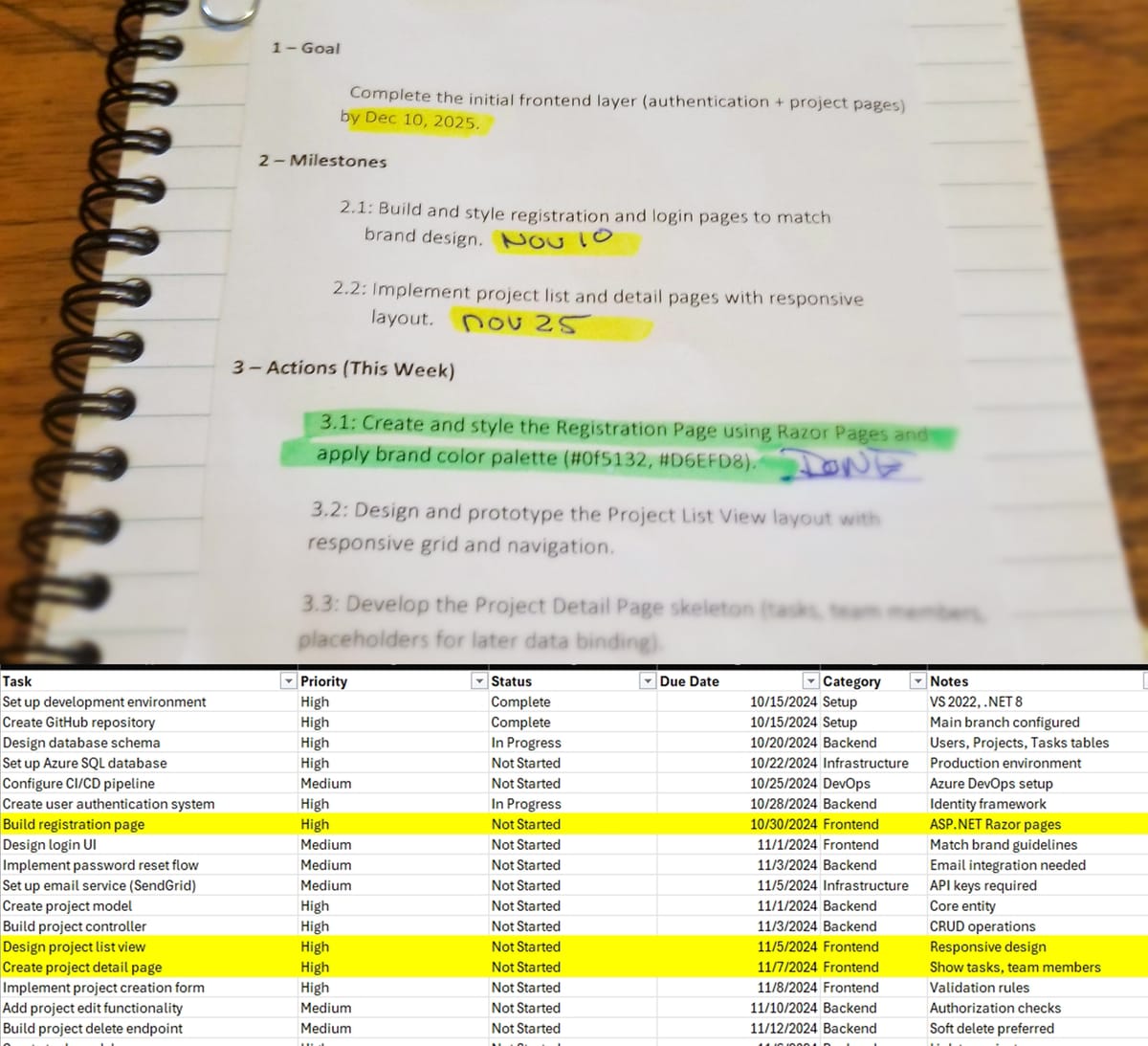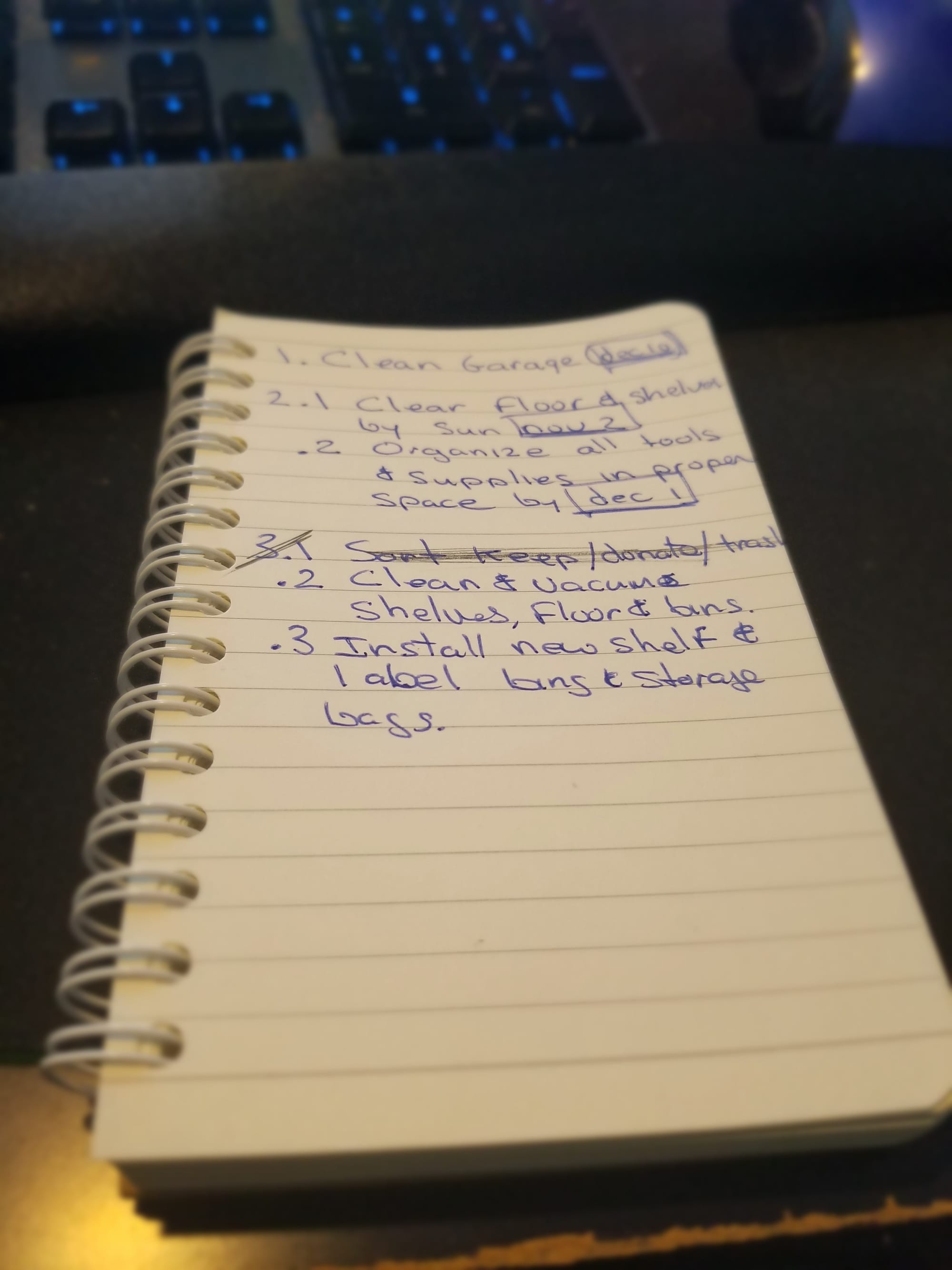The 1-2-3 Focus Method: A Simple System to Beat Decision Paralysis and Get Things Done
Stuck in endless planning loops and pretty to-do lists? The 1-2-3 Focus Method helps you cut through noise with one goal, two milestones, and three daily actions, a minimalist system to regain focus and move forward.

The Envelope Moment
It was 1:53 a.m. on a Tuesday, and I was three weeks behind on a software deadline. My Excel sheet had become an archaeological site of abandoned jobs.My task manager showed fifteen color-coded priorities, meaning nothing had priority.
I’d read Getting Things Done twice. The issue wasn’t organization; I couldn’t decide what mattered most.
In frustration, I grabbed a torn envelope from the trash and wrote three layers:
- Ship the update by Feb 15
- Finish core module / Get client approval
- Fix display bug / Build save function / Email QA lead
No tags. No dashboards. Just a hierarchy I could see at a quick glance.
By Friday, the update shipped.
That night made me realize something bigger: We don’t need more systems; we need fewer decisions.
Goal-setting frameworks are everywhere: OKRs, GTD’s Horizons of Focus, SMART goals, the Eisenhower Matrix. Most share the same premise: define what matters, break it down, and focus on fewer things simultaneously.
The problem isn’t that these frameworks are wrong.
It’s when you’re drowning in competing priorities, most of which are too heavy to hold in your head. Too many fields to fill. There is too much friction between “I need to decide” and “I’m doing it.”
I needed something simpler -Post-it simple- but structured enough to force real decisions instead of organizing my anxiety into prettier lists. So, I stripped execution down to its core:
One goal.
Two milestones.
Three actions.
We don’t need better tools. We need permission to make hard choices. Organizing without prioritization is elegant procrastination. Looking back, I realized I hadn’t invented anything new. I’d just made the classic project hierarchy brutally simple:
- Define the outcome: What’s the one thing that matters now? (1 Goal)
- Identify checkpoints: What would prove progress? (2 Milestones)
- List the next actions: What can I start today? (3 Actions)
That scrap piece of an envelope became a Post-it. The Post-it became a habit.
The habit became the 1-2-3 Focus Method, mostly because I needed a name to keep it structured in my mind.
This is what it is, why it works, and when it doesn’t.
The Emotional Elephant Under Your To-Do List
Structure can’t overcome avoidance alone. When you keep dodging a task, the issue isn’t organization; it’s emotion.
Research on affect labeling suggests that simply naming an emotion can reduce intensity. Pair that with shrinking the task to the tiniest possible version, and you can restart momentum without waiting for willpower.
When stuck, try:
- Which action am I avoiding?
- What emotion is behind it? (fear, boredom, uncertainty, resentment)
- What’s the smallest version I can do right now?
An Example:
Avoiding: Email five potential customers.
Feeling: Fear of rejection.
Small step: Draft one email without sending it.
This won’t fix deep avoidance rooted in burnout or clinical anxiety. But for everyday resistance, naming the feeling and shrinking the task often gets you moving.
What It Is, and Why It Works.
The 1-2-3 method builds on established principles:
- Define what matters (clarity)
- Break it down (progress visibility)
- Limit scope (cognitive load)
It’s tool-agnostic and rigid enough to force decisions without becoming a bureaucracy. Think of it as a decision-forcing scaffold for when clarity collapses.
Layers at a glance
| Layer | Focus | Purpose | Example |
|---|---|---|---|
| 1 – Goal | North Star | Filters decisions | Publish book by Jan 16, 2026 |
| 2 – Milestones | Progress markers | Create visible checkpoints | Draft done / Email list built |
| 3 – Actions | Concrete steps | Generate daily momentum | Write 1,500 words / Contact 3 prospects |
- OKRs: Team/quarterly alignment. 1-2-3 = individual, weeks-to-months execution.
- GTD: Capture and organize everything. 1-2-3 = choosing what to do now.
- Eisenhower Matrix: This matrix helps you sort urgent vs. important. 1-2-3: Assume you've sorted, and now act on the important. 1-2-3 = act on the important.
- Time-blocking/Deep Work: Calendar strategies to protect focus time. 1-2-3: Decides what to do during that time. 1-2-3 = fill that time with aligned steps.
Pattern: Most systems solve different problems. 1-2-3 addresses: "I have too many competing priorities and can't decide what to work on." If that's not your problem, this isn't your tool.
Enjoying the journey so far?
If you like deep dives into creative chaos, productivity under pressure, and nerdy lessons from real-life experiments, subscribe to get future posts delivered right to your inbox. Subscribe Now
Why Constraints Work

The structure addresses three well-documented challenges:
The Science Behind It
- Specific, challenging goals improve performance. A single, concrete goal creates a stable decision filter.
- Implementation intentions bridge the intention-action gap.
Pre-determined milestones and actions reduce cognitive drag from constant re-planning. - Working memory is limited. Constraining to 1-2-3 respects cognitive capacity instead of fighting it.
The numbers are flexible, the principle isn't.
1-3-5 or 1-2-4 might suit your context. What's non-negotiable is the single active execution focus. You don't have one goal in life; you have multiple roles. But at any given time, ask: What's the one thing I'm deliberately moving forward with right now?
For some, it's a two-week marathon on a work project. For others, it's a three-month commitment to a personal outcome. The timeframe matters less than the commitment to push one thing beyond maintenance mode.
If you're balancing multiple domains (client work, team leadership, personal project), create a separate 1-2-3 for each, then choose which domain gets priority daily or weekly. Constraint isn't denying reality; it's accepting that you can't advance everything simultaneously with equal focus.
An Example in Action
My “1” (Goal):
Self-publish The 1-2-3 Focus Method (45,000 words) by Jan 16, 2026.
My “2” (Milestones):
- 2.1 Draft complete by Dec 15
- 2.2 Email list to 2,000 by Nov 30
My “3” (This Week’s Actions):
- 3.1 Write 1,500 words for Chapter 4
- 3.2 Draft social post for list-building
- 3.3 Research three cover designers
The reality: Notice that action 3.3 doesn’t advance either milestone, it’s prep for a future need. That’s a signal to either add a new milestone, or replace 3.3 with something that moves 2.1 or 2.2 this week. The tension is valid; it exposes avoidance.
“One goal” clarified: I’m not ignoring health, relationships, or my day job. Those continue in maintenance mode. For this 8–10-week execution cycle, this is the project I’m deliberately advancing.
Common Mistakes (and Fixes)
Lesson: Before committing, ask: "If I achieve this perfectly, does it solve the core problem?" If you're not sure, your "1" should be Validate [assumption] by [date], not Build [solution] by [date].
Another faiure mode: In highly reactive environments (see 'When It Works' section), the framework assumes control over time you might not have.
Adaptation: Use session-based actions. Whenever a 45-minute window appears, pick one action. Some days you'll do none, some days two. Over two weeks, momentum still compounds, more slowly, but reliably.
Point: This isn't magic. It's a focusing constraint. If your core constraint is unclear goals, no control over time, or systemic chaos, another layer of structure won't help.
Example of Common Mistakes (and Fixes)
1) An Obscure “1.”
- Bad: Get healthier.
- Fix: Run a 5K by Mar 15.
Why: Vague goals don’t filter decisions.
2) Unclear milestones.
- Bad: Make progress on research.
- Fix: Interview 10 users by Nov 15.
Why: Milestones must be binary and dated.
3) Weak actions.
- Bad: organize notes, update outline, read more.
- Fix: Choose one and replace with “Write 500 words of a draft” to force execution.
4) Hitting actions but no milestone movement.
- Signal: Doing Adjacent work.
- Fix: Ask, if I do these three things, will the milestone (2’s) measurably advance? If not, choose more complex actions.
5) Adding a fourth action “just this once.”
- Reality: You’ll keep adding.
- Fix: Combine two or cut one. The discomfort is the point.
The Guardrails
- Constraint protects you. If you have two “1s” or six “3s,” you’ve lost the edge.
- Ship at 80%. Momentum beats perfection. “Done” builds progress; “perfect” delays it.
- Experiment don’t worship. If 2-3-4 or 1-1-5 fits your work, adapt ratios, not the principle.
Run a two-week trial, then judge.
If it reduces decision friction and advances milestones, keep it.
If not, drop it without guilt; systems are tools, not identities.
Signs it’s working
Measurable milestone movement; less time deciding; clarity about what you’re not doing.
Needs adjustment
If you ignore your “3”; milestones stall; you’re maintaining the framework more than executing.
Not for you:
If your work is too reactive for any planning structure; your real problem is unclear goals; it feels like an obligation, not a clarifying tool.
Closing the Tab (Before Opening a New One)
Most productivity advice assumes you need better tools. Sometimes you do. Often, what's missing is a forcing process, something that makes you pick one thing and commit.
That's all this is: structured permission to stop hedging. One goal, two milestones, three actions.
If your problem is decision paralysis disguised as organization, this might help. If your problem is execution, energy, or systemic chaos, it probably won't.
Try it for two weeks. Define your 1-2-3. Reset actions daily. Review weekly.
If it reduces friction and moves your milestones, keep it. If not, drop it without guilt; you've spent two weeks learning how your mind works under constraint.
Either way, that’s useful, because clarity, like a clean garage, always creates space for what matters next.
Stay curious, stay nerdy, and stay aligned.
If you like deep dives into creative chaos, productivity under pressure, and nerdy lessons from real-life experiments, subscribe to get future posts delivered right to your inbox. Subscribe Now